MAE101 Economics Assignment: Vancouver Housing Market Analysis
VerifiedAdded on 2023/06/08
|15
|3107
|353
Homework Assignment
AI Summary
This economics assignment analyzes the housing market crisis in Vancouver, Canada, focusing on the factors contributing to the affordability crisis. It examines both demand-side factors (population growth, investment, foreign buyers) and supply-side factors (housing stock, wage rates, zoning laws) that influence the market. The assignment delves into the demand curves of homeowners and investors, and the impacts of government policies like increased foreign-buyer taxes and property taxes on second homes. The analysis includes diagrammatic representations of the effects of demand management policies and how different supply elasticities affect outcomes. Furthermore, it explores the implications of taxing empty homes on the rental market and compares Vancouver's situation to housing market challenges in Australia. The assignment provides a comprehensive understanding of the economic principles at play in the Vancouver housing market and potential policy solutions.
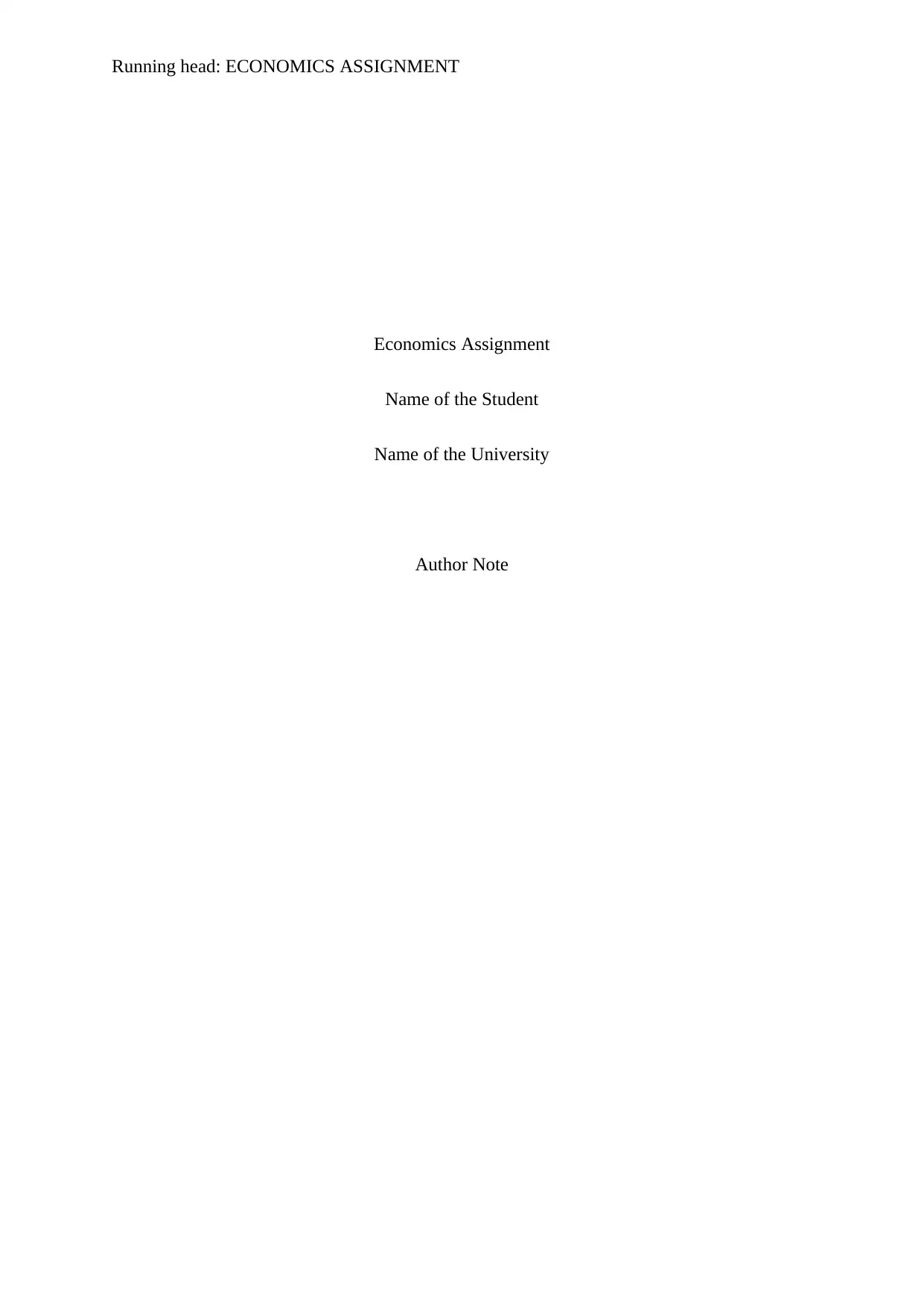
Running head: ECONOMICS ASSIGNMENT
Economics Assignment
Name of the Student
Name of the University
Author Note
Economics Assignment
Name of the Student
Name of the University
Author Note
Paraphrase This Document
Need a fresh take? Get an instant paraphrase of this document with our AI Paraphraser
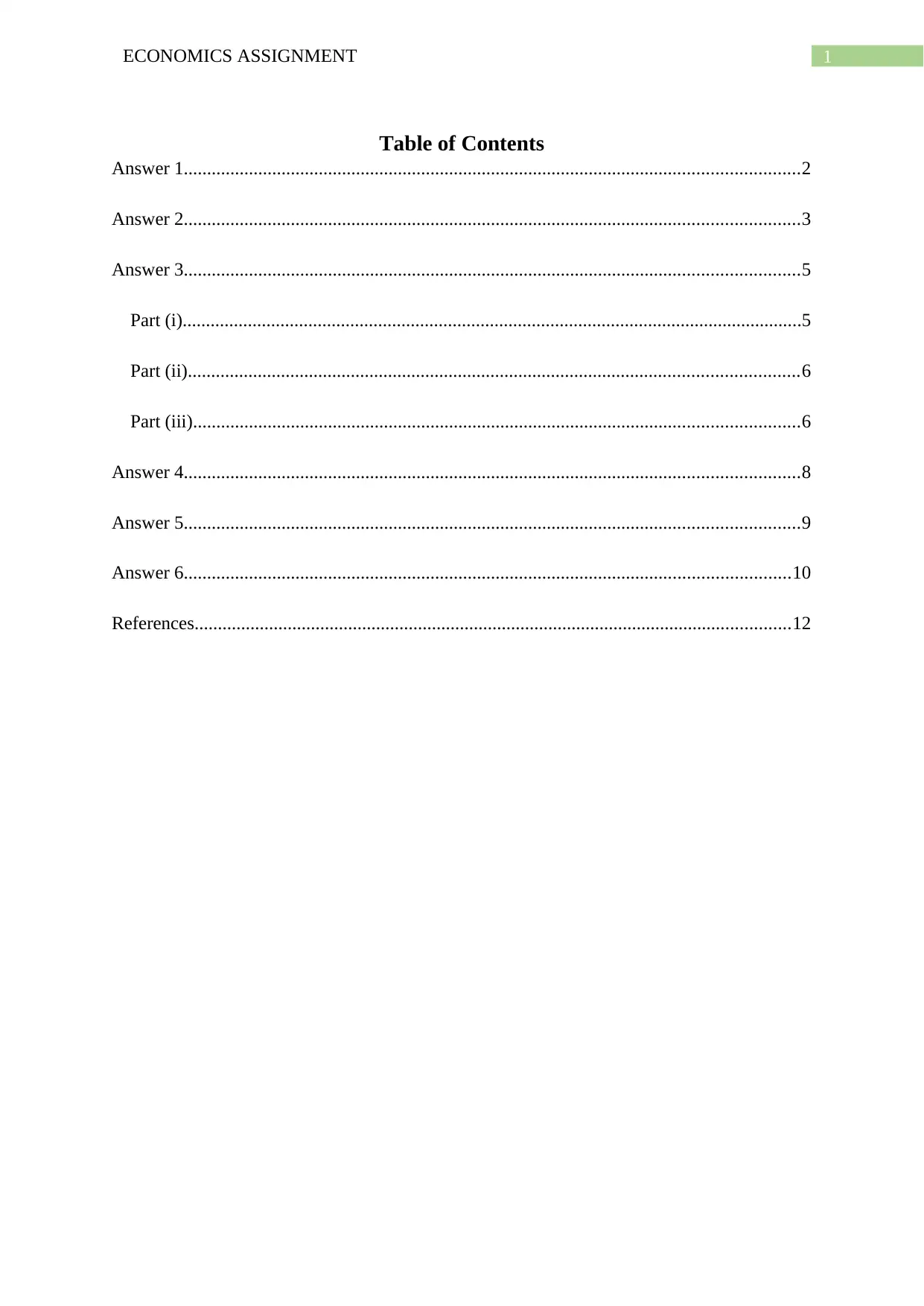
1ECONOMICS ASSIGNMENT
Table of Contents
Answer 1....................................................................................................................................2
Answer 2....................................................................................................................................3
Answer 3....................................................................................................................................5
Part (i).....................................................................................................................................5
Part (ii)...................................................................................................................................6
Part (iii)..................................................................................................................................6
Answer 4....................................................................................................................................8
Answer 5....................................................................................................................................9
Answer 6..................................................................................................................................10
References................................................................................................................................12
Table of Contents
Answer 1....................................................................................................................................2
Answer 2....................................................................................................................................3
Answer 3....................................................................................................................................5
Part (i).....................................................................................................................................5
Part (ii)...................................................................................................................................6
Part (iii)..................................................................................................................................6
Answer 4....................................................................................................................................8
Answer 5....................................................................................................................................9
Answer 6..................................................................................................................................10
References................................................................................................................................12
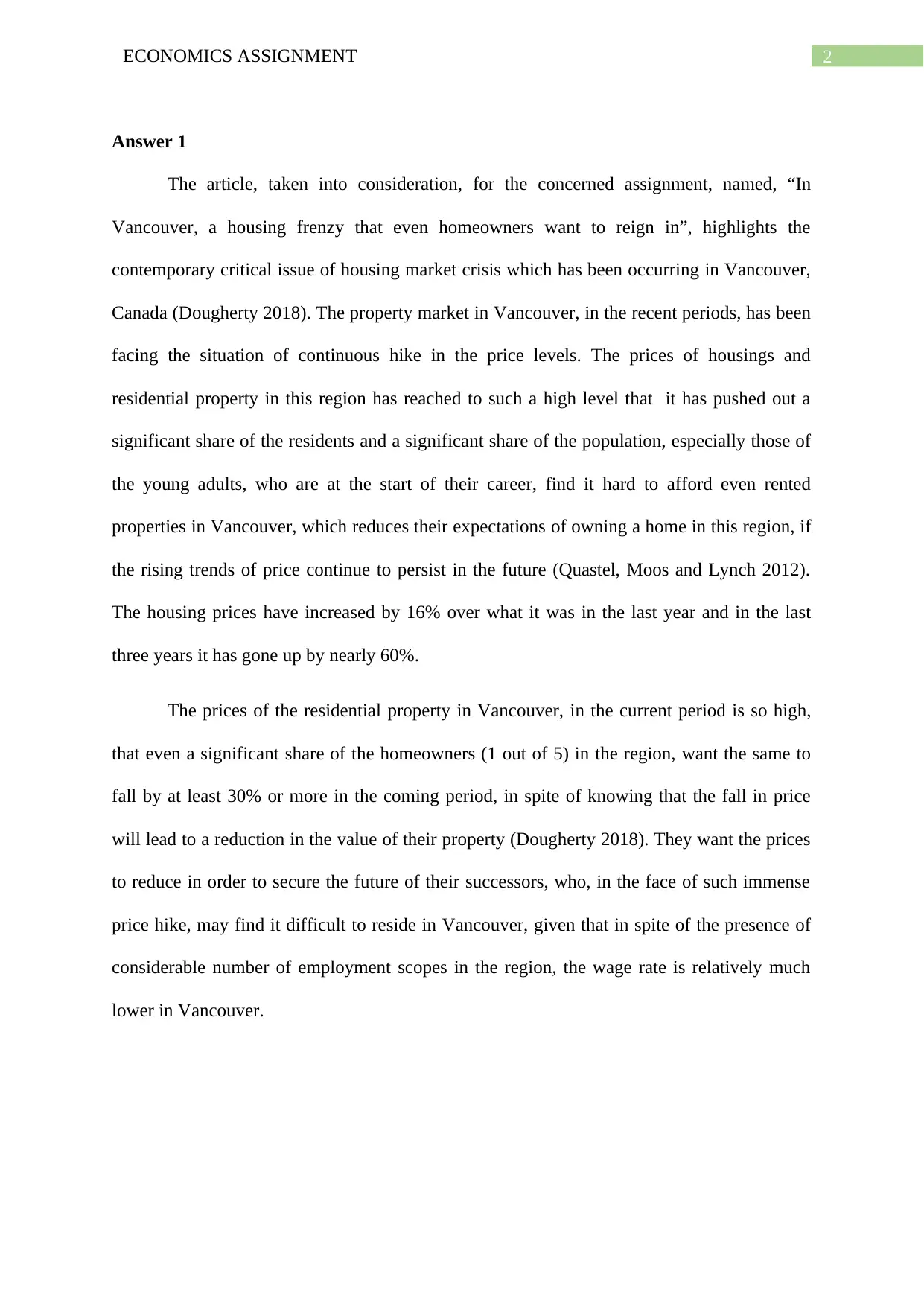
2ECONOMICS ASSIGNMENT
Answer 1
The article, taken into consideration, for the concerned assignment, named, “In
Vancouver, a housing frenzy that even homeowners want to reign in”, highlights the
contemporary critical issue of housing market crisis which has been occurring in Vancouver,
Canada (Dougherty 2018). The property market in Vancouver, in the recent periods, has been
facing the situation of continuous hike in the price levels. The prices of housings and
residential property in this region has reached to such a high level that it has pushed out a
significant share of the residents and a significant share of the population, especially those of
the young adults, who are at the start of their career, find it hard to afford even rented
properties in Vancouver, which reduces their expectations of owning a home in this region, if
the rising trends of price continue to persist in the future (Quastel, Moos and Lynch 2012).
The housing prices have increased by 16% over what it was in the last year and in the last
three years it has gone up by nearly 60%.
The prices of the residential property in Vancouver, in the current period is so high,
that even a significant share of the homeowners (1 out of 5) in the region, want the same to
fall by at least 30% or more in the coming period, in spite of knowing that the fall in price
will lead to a reduction in the value of their property (Dougherty 2018). They want the prices
to reduce in order to secure the future of their successors, who, in the face of such immense
price hike, may find it difficult to reside in Vancouver, given that in spite of the presence of
considerable number of employment scopes in the region, the wage rate is relatively much
lower in Vancouver.
Answer 1
The article, taken into consideration, for the concerned assignment, named, “In
Vancouver, a housing frenzy that even homeowners want to reign in”, highlights the
contemporary critical issue of housing market crisis which has been occurring in Vancouver,
Canada (Dougherty 2018). The property market in Vancouver, in the recent periods, has been
facing the situation of continuous hike in the price levels. The prices of housings and
residential property in this region has reached to such a high level that it has pushed out a
significant share of the residents and a significant share of the population, especially those of
the young adults, who are at the start of their career, find it hard to afford even rented
properties in Vancouver, which reduces their expectations of owning a home in this region, if
the rising trends of price continue to persist in the future (Quastel, Moos and Lynch 2012).
The housing prices have increased by 16% over what it was in the last year and in the last
three years it has gone up by nearly 60%.
The prices of the residential property in Vancouver, in the current period is so high,
that even a significant share of the homeowners (1 out of 5) in the region, want the same to
fall by at least 30% or more in the coming period, in spite of knowing that the fall in price
will lead to a reduction in the value of their property (Dougherty 2018). They want the prices
to reduce in order to secure the future of their successors, who, in the face of such immense
price hike, may find it difficult to reside in Vancouver, given that in spite of the presence of
considerable number of employment scopes in the region, the wage rate is relatively much
lower in Vancouver.
⊘ This is a preview!⊘
Do you want full access?
Subscribe today to unlock all pages.

Trusted by 1+ million students worldwide
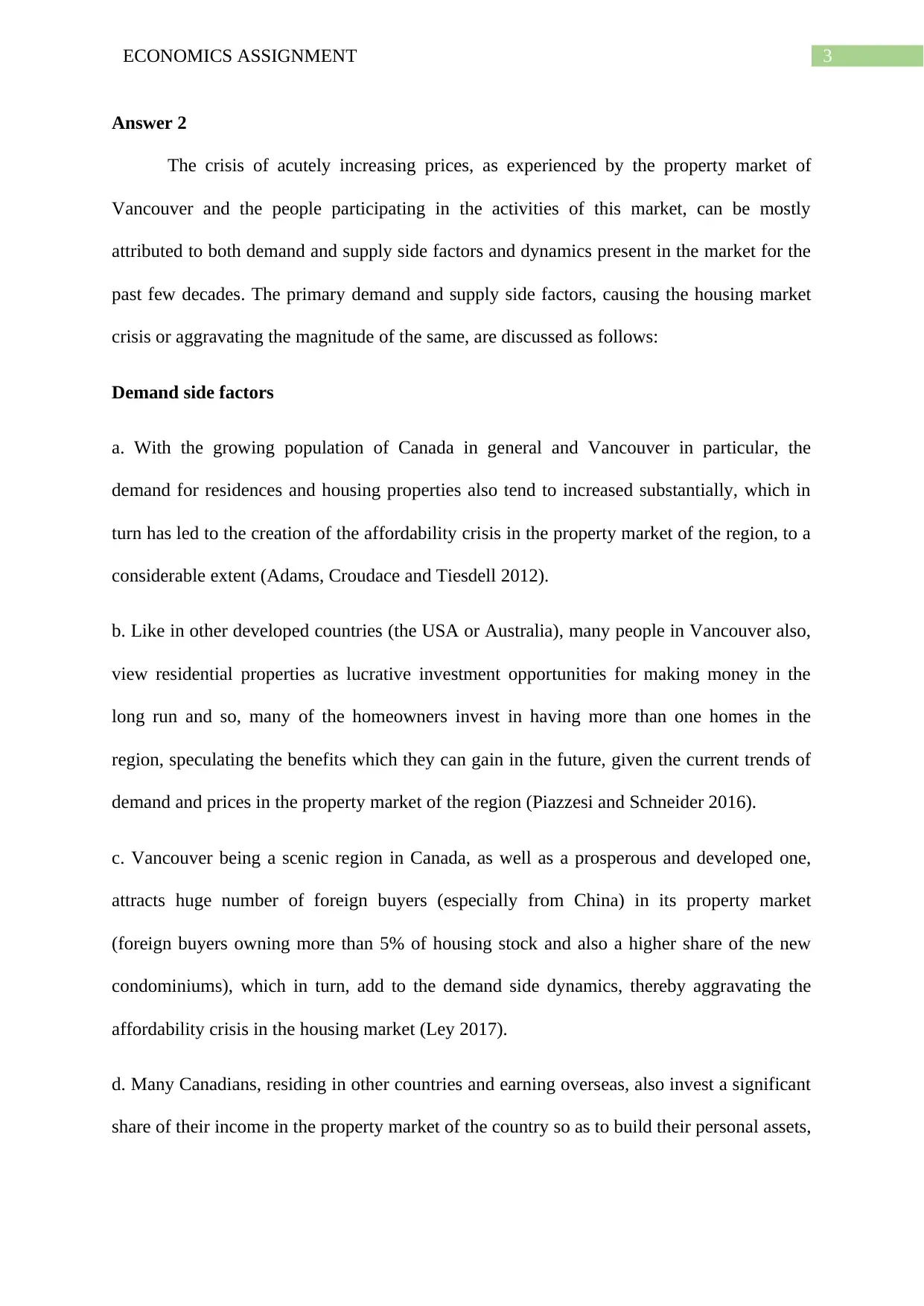
3ECONOMICS ASSIGNMENT
Answer 2
The crisis of acutely increasing prices, as experienced by the property market of
Vancouver and the people participating in the activities of this market, can be mostly
attributed to both demand and supply side factors and dynamics present in the market for the
past few decades. The primary demand and supply side factors, causing the housing market
crisis or aggravating the magnitude of the same, are discussed as follows:
Demand side factors
a. With the growing population of Canada in general and Vancouver in particular, the
demand for residences and housing properties also tend to increased substantially, which in
turn has led to the creation of the affordability crisis in the property market of the region, to a
considerable extent (Adams, Croudace and Tiesdell 2012).
b. Like in other developed countries (the USA or Australia), many people in Vancouver also,
view residential properties as lucrative investment opportunities for making money in the
long run and so, many of the homeowners invest in having more than one homes in the
region, speculating the benefits which they can gain in the future, given the current trends of
demand and prices in the property market of the region (Piazzesi and Schneider 2016).
c. Vancouver being a scenic region in Canada, as well as a prosperous and developed one,
attracts huge number of foreign buyers (especially from China) in its property market
(foreign buyers owning more than 5% of housing stock and also a higher share of the new
condominiums), which in turn, add to the demand side dynamics, thereby aggravating the
affordability crisis in the housing market (Ley 2017).
d. Many Canadians, residing in other countries and earning overseas, also invest a significant
share of their income in the property market of the country so as to build their personal assets,
Answer 2
The crisis of acutely increasing prices, as experienced by the property market of
Vancouver and the people participating in the activities of this market, can be mostly
attributed to both demand and supply side factors and dynamics present in the market for the
past few decades. The primary demand and supply side factors, causing the housing market
crisis or aggravating the magnitude of the same, are discussed as follows:
Demand side factors
a. With the growing population of Canada in general and Vancouver in particular, the
demand for residences and housing properties also tend to increased substantially, which in
turn has led to the creation of the affordability crisis in the property market of the region, to a
considerable extent (Adams, Croudace and Tiesdell 2012).
b. Like in other developed countries (the USA or Australia), many people in Vancouver also,
view residential properties as lucrative investment opportunities for making money in the
long run and so, many of the homeowners invest in having more than one homes in the
region, speculating the benefits which they can gain in the future, given the current trends of
demand and prices in the property market of the region (Piazzesi and Schneider 2016).
c. Vancouver being a scenic region in Canada, as well as a prosperous and developed one,
attracts huge number of foreign buyers (especially from China) in its property market
(foreign buyers owning more than 5% of housing stock and also a higher share of the new
condominiums), which in turn, add to the demand side dynamics, thereby aggravating the
affordability crisis in the housing market (Ley 2017).
d. Many Canadians, residing in other countries and earning overseas, also invest a significant
share of their income in the property market of the country so as to build their personal assets,
Paraphrase This Document
Need a fresh take? Get an instant paraphrase of this document with our AI Paraphraser
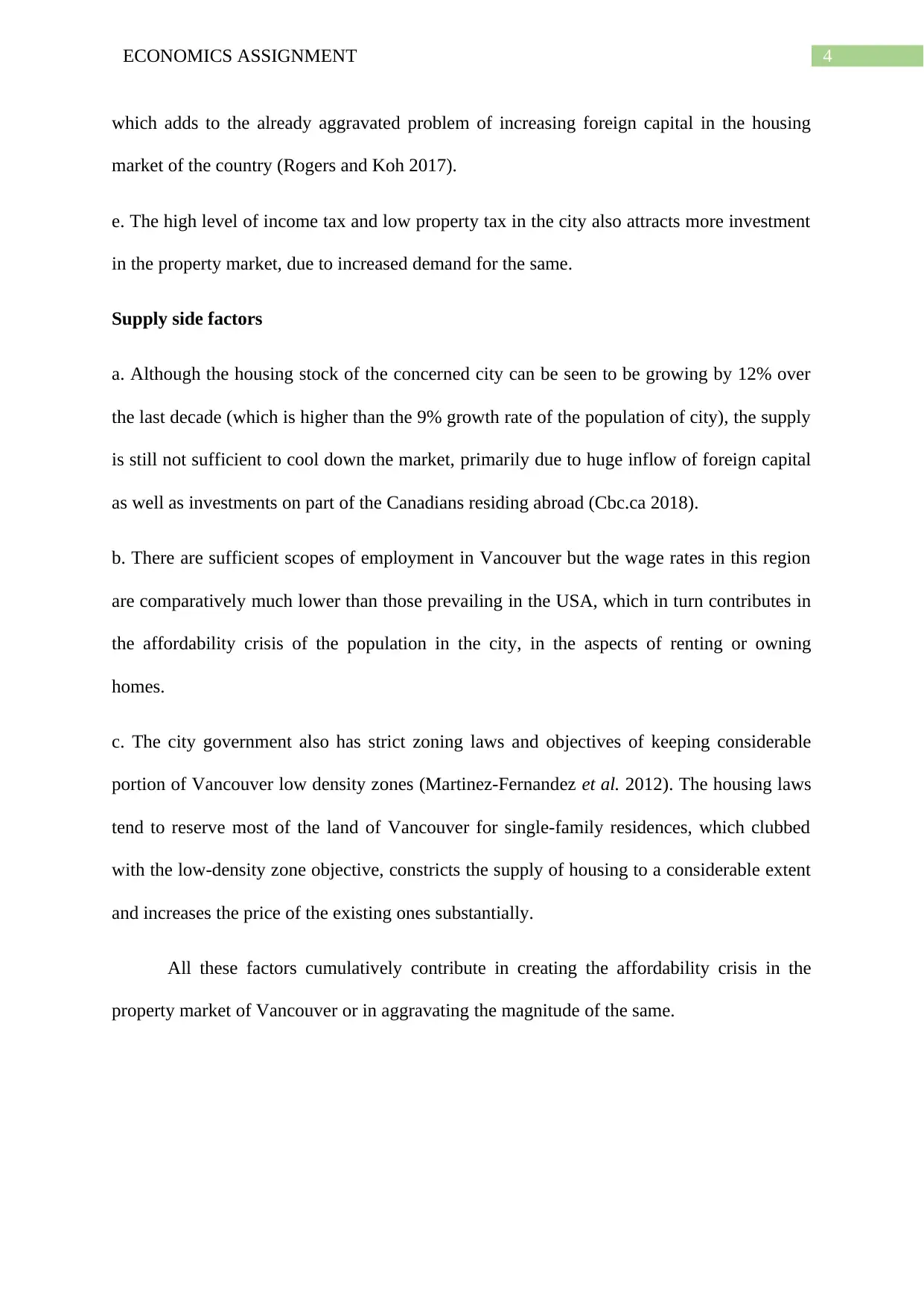
4ECONOMICS ASSIGNMENT
which adds to the already aggravated problem of increasing foreign capital in the housing
market of the country (Rogers and Koh 2017).
e. The high level of income tax and low property tax in the city also attracts more investment
in the property market, due to increased demand for the same.
Supply side factors
a. Although the housing stock of the concerned city can be seen to be growing by 12% over
the last decade (which is higher than the 9% growth rate of the population of city), the supply
is still not sufficient to cool down the market, primarily due to huge inflow of foreign capital
as well as investments on part of the Canadians residing abroad (Cbc.ca 2018).
b. There are sufficient scopes of employment in Vancouver but the wage rates in this region
are comparatively much lower than those prevailing in the USA, which in turn contributes in
the affordability crisis of the population in the city, in the aspects of renting or owning
homes.
c. The city government also has strict zoning laws and objectives of keeping considerable
portion of Vancouver low density zones (Martinez‐Fernandez et al. 2012). The housing laws
tend to reserve most of the land of Vancouver for single-family residences, which clubbed
with the low-density zone objective, constricts the supply of housing to a considerable extent
and increases the price of the existing ones substantially.
All these factors cumulatively contribute in creating the affordability crisis in the
property market of Vancouver or in aggravating the magnitude of the same.
which adds to the already aggravated problem of increasing foreign capital in the housing
market of the country (Rogers and Koh 2017).
e. The high level of income tax and low property tax in the city also attracts more investment
in the property market, due to increased demand for the same.
Supply side factors
a. Although the housing stock of the concerned city can be seen to be growing by 12% over
the last decade (which is higher than the 9% growth rate of the population of city), the supply
is still not sufficient to cool down the market, primarily due to huge inflow of foreign capital
as well as investments on part of the Canadians residing abroad (Cbc.ca 2018).
b. There are sufficient scopes of employment in Vancouver but the wage rates in this region
are comparatively much lower than those prevailing in the USA, which in turn contributes in
the affordability crisis of the population in the city, in the aspects of renting or owning
homes.
c. The city government also has strict zoning laws and objectives of keeping considerable
portion of Vancouver low density zones (Martinez‐Fernandez et al. 2012). The housing laws
tend to reserve most of the land of Vancouver for single-family residences, which clubbed
with the low-density zone objective, constricts the supply of housing to a considerable extent
and increases the price of the existing ones substantially.
All these factors cumulatively contribute in creating the affordability crisis in the
property market of Vancouver or in aggravating the magnitude of the same.
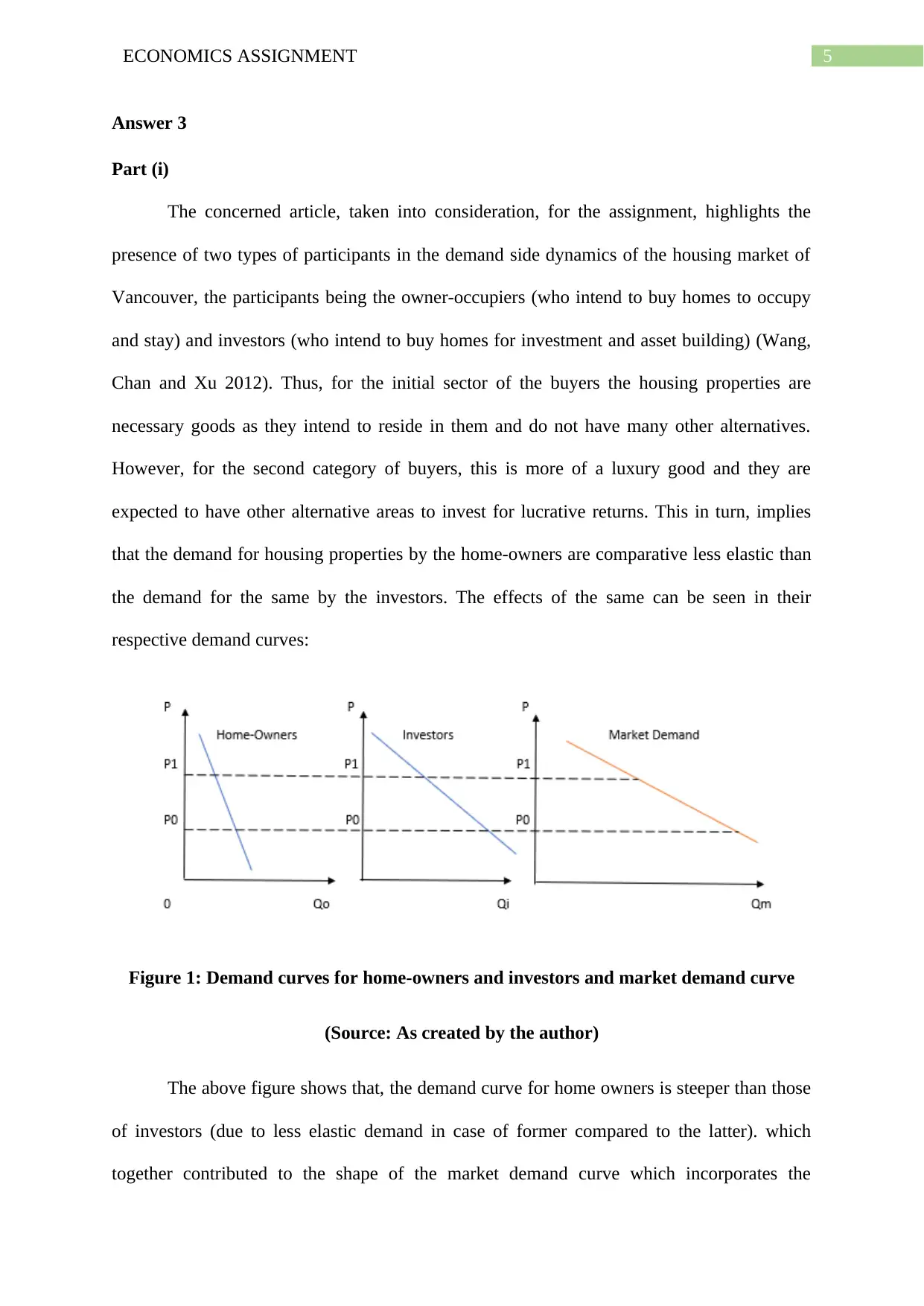
5ECONOMICS ASSIGNMENT
Answer 3
Part (i)
The concerned article, taken into consideration, for the assignment, highlights the
presence of two types of participants in the demand side dynamics of the housing market of
Vancouver, the participants being the owner-occupiers (who intend to buy homes to occupy
and stay) and investors (who intend to buy homes for investment and asset building) (Wang,
Chan and Xu 2012). Thus, for the initial sector of the buyers the housing properties are
necessary goods as they intend to reside in them and do not have many other alternatives.
However, for the second category of buyers, this is more of a luxury good and they are
expected to have other alternative areas to invest for lucrative returns. This in turn, implies
that the demand for housing properties by the home-owners are comparative less elastic than
the demand for the same by the investors. The effects of the same can be seen in their
respective demand curves:
Figure 1: Demand curves for home-owners and investors and market demand curve
(Source: As created by the author)
The above figure shows that, the demand curve for home owners is steeper than those
of investors (due to less elastic demand in case of former compared to the latter). which
together contributed to the shape of the market demand curve which incorporates the
Answer 3
Part (i)
The concerned article, taken into consideration, for the assignment, highlights the
presence of two types of participants in the demand side dynamics of the housing market of
Vancouver, the participants being the owner-occupiers (who intend to buy homes to occupy
and stay) and investors (who intend to buy homes for investment and asset building) (Wang,
Chan and Xu 2012). Thus, for the initial sector of the buyers the housing properties are
necessary goods as they intend to reside in them and do not have many other alternatives.
However, for the second category of buyers, this is more of a luxury good and they are
expected to have other alternative areas to invest for lucrative returns. This in turn, implies
that the demand for housing properties by the home-owners are comparative less elastic than
the demand for the same by the investors. The effects of the same can be seen in their
respective demand curves:
Figure 1: Demand curves for home-owners and investors and market demand curve
(Source: As created by the author)
The above figure shows that, the demand curve for home owners is steeper than those
of investors (due to less elastic demand in case of former compared to the latter). which
together contributed to the shape of the market demand curve which incorporates the
⊘ This is a preview!⊘
Do you want full access?
Subscribe today to unlock all pages.

Trusted by 1+ million students worldwide
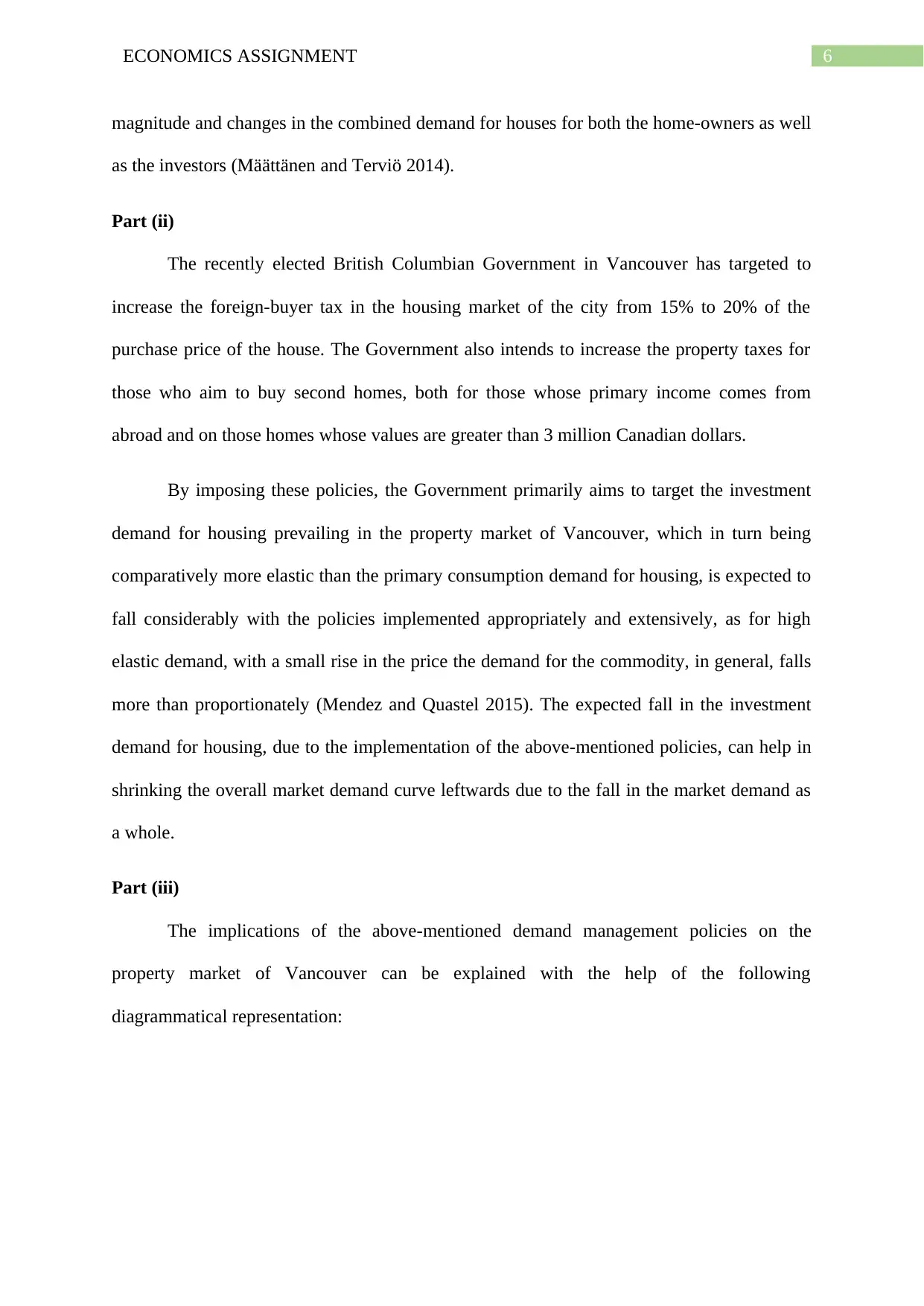
6ECONOMICS ASSIGNMENT
magnitude and changes in the combined demand for houses for both the home-owners as well
as the investors (Määttänen and Terviö 2014).
Part (ii)
The recently elected British Columbian Government in Vancouver has targeted to
increase the foreign-buyer tax in the housing market of the city from 15% to 20% of the
purchase price of the house. The Government also intends to increase the property taxes for
those who aim to buy second homes, both for those whose primary income comes from
abroad and on those homes whose values are greater than 3 million Canadian dollars.
By imposing these policies, the Government primarily aims to target the investment
demand for housing prevailing in the property market of Vancouver, which in turn being
comparatively more elastic than the primary consumption demand for housing, is expected to
fall considerably with the policies implemented appropriately and extensively, as for high
elastic demand, with a small rise in the price the demand for the commodity, in general, falls
more than proportionately (Mendez and Quastel 2015). The expected fall in the investment
demand for housing, due to the implementation of the above-mentioned policies, can help in
shrinking the overall market demand curve leftwards due to the fall in the market demand as
a whole.
Part (iii)
The implications of the above-mentioned demand management policies on the
property market of Vancouver can be explained with the help of the following
diagrammatical representation:
magnitude and changes in the combined demand for houses for both the home-owners as well
as the investors (Määttänen and Terviö 2014).
Part (ii)
The recently elected British Columbian Government in Vancouver has targeted to
increase the foreign-buyer tax in the housing market of the city from 15% to 20% of the
purchase price of the house. The Government also intends to increase the property taxes for
those who aim to buy second homes, both for those whose primary income comes from
abroad and on those homes whose values are greater than 3 million Canadian dollars.
By imposing these policies, the Government primarily aims to target the investment
demand for housing prevailing in the property market of Vancouver, which in turn being
comparatively more elastic than the primary consumption demand for housing, is expected to
fall considerably with the policies implemented appropriately and extensively, as for high
elastic demand, with a small rise in the price the demand for the commodity, in general, falls
more than proportionately (Mendez and Quastel 2015). The expected fall in the investment
demand for housing, due to the implementation of the above-mentioned policies, can help in
shrinking the overall market demand curve leftwards due to the fall in the market demand as
a whole.
Part (iii)
The implications of the above-mentioned demand management policies on the
property market of Vancouver can be explained with the help of the following
diagrammatical representation:
Paraphrase This Document
Need a fresh take? Get an instant paraphrase of this document with our AI Paraphraser
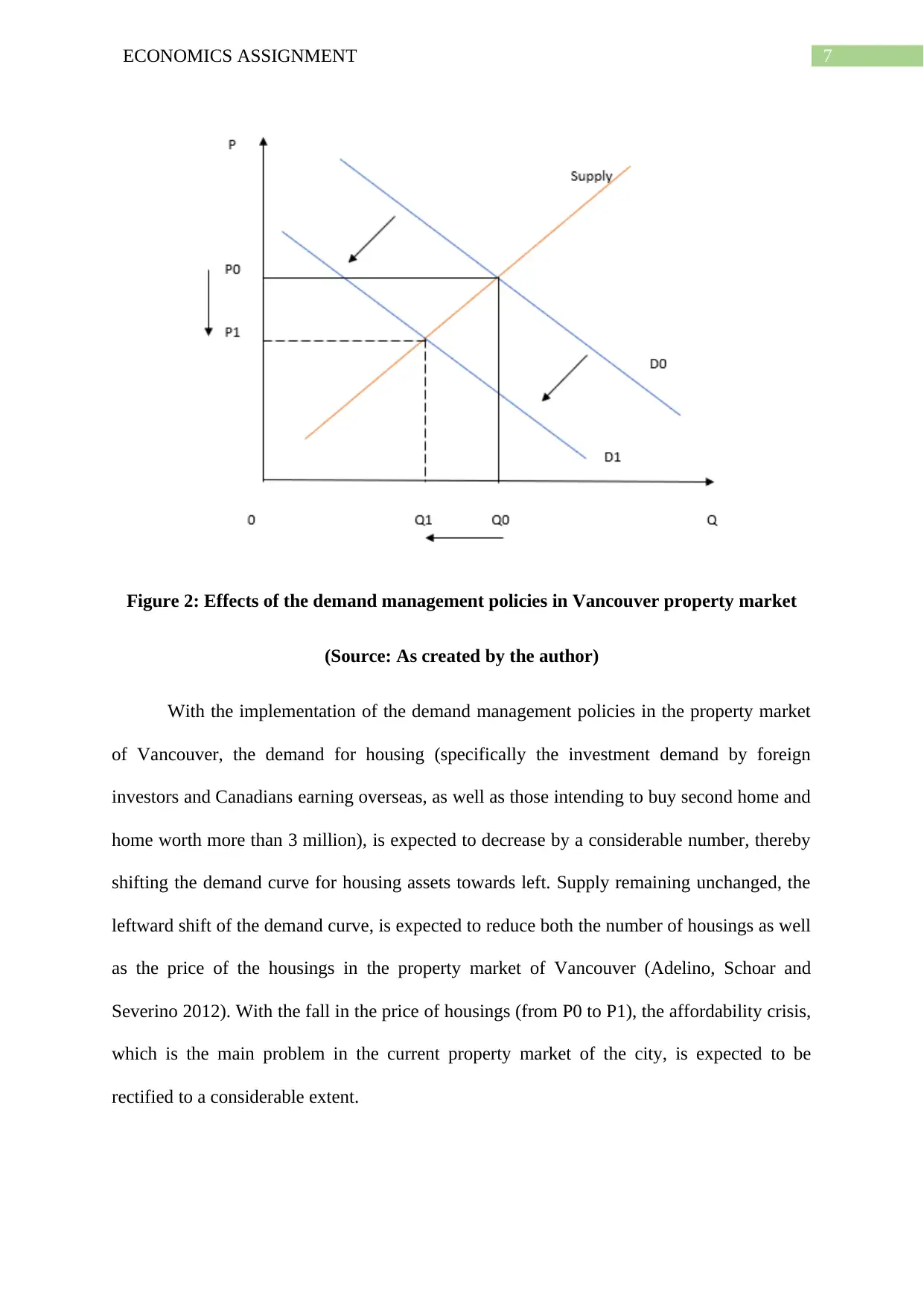
7ECONOMICS ASSIGNMENT
Figure 2: Effects of the demand management policies in Vancouver property market
(Source: As created by the author)
With the implementation of the demand management policies in the property market
of Vancouver, the demand for housing (specifically the investment demand by foreign
investors and Canadians earning overseas, as well as those intending to buy second home and
home worth more than 3 million), is expected to decrease by a considerable number, thereby
shifting the demand curve for housing assets towards left. Supply remaining unchanged, the
leftward shift of the demand curve, is expected to reduce both the number of housings as well
as the price of the housings in the property market of Vancouver (Adelino, Schoar and
Severino 2012). With the fall in the price of housings (from P0 to P1), the affordability crisis,
which is the main problem in the current property market of the city, is expected to be
rectified to a considerable extent.
Figure 2: Effects of the demand management policies in Vancouver property market
(Source: As created by the author)
With the implementation of the demand management policies in the property market
of Vancouver, the demand for housing (specifically the investment demand by foreign
investors and Canadians earning overseas, as well as those intending to buy second home and
home worth more than 3 million), is expected to decrease by a considerable number, thereby
shifting the demand curve for housing assets towards left. Supply remaining unchanged, the
leftward shift of the demand curve, is expected to reduce both the number of housings as well
as the price of the housings in the property market of Vancouver (Adelino, Schoar and
Severino 2012). With the fall in the price of housings (from P0 to P1), the affordability crisis,
which is the main problem in the current property market of the city, is expected to be
rectified to a considerable extent.
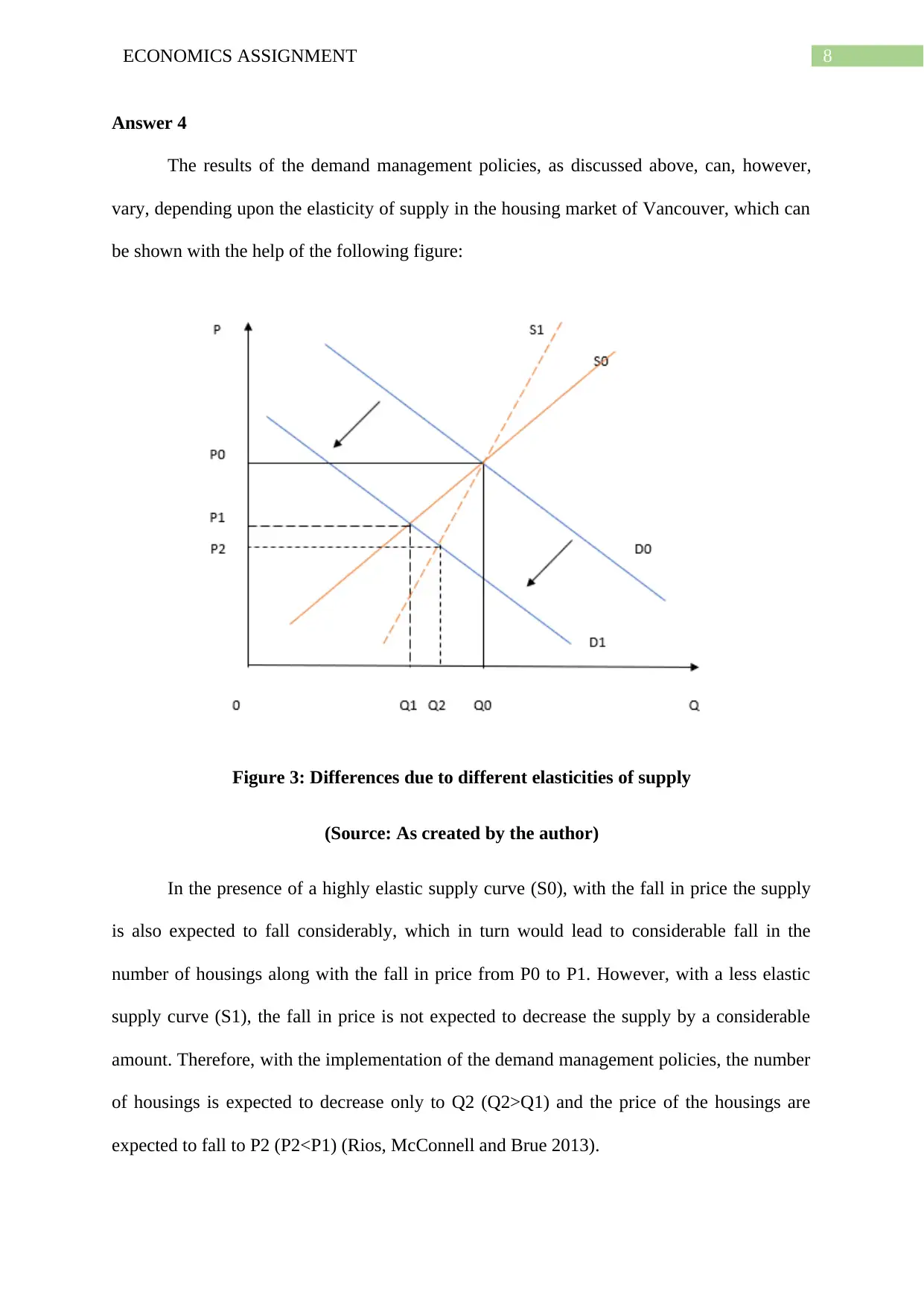
8ECONOMICS ASSIGNMENT
Answer 4
The results of the demand management policies, as discussed above, can, however,
vary, depending upon the elasticity of supply in the housing market of Vancouver, which can
be shown with the help of the following figure:
Figure 3: Differences due to different elasticities of supply
(Source: As created by the author)
In the presence of a highly elastic supply curve (S0), with the fall in price the supply
is also expected to fall considerably, which in turn would lead to considerable fall in the
number of housings along with the fall in price from P0 to P1. However, with a less elastic
supply curve (S1), the fall in price is not expected to decrease the supply by a considerable
amount. Therefore, with the implementation of the demand management policies, the number
of housings is expected to decrease only to Q2 (Q2>Q1) and the price of the housings are
expected to fall to P2 (P2<P1) (Rios, McConnell and Brue 2013).
Answer 4
The results of the demand management policies, as discussed above, can, however,
vary, depending upon the elasticity of supply in the housing market of Vancouver, which can
be shown with the help of the following figure:
Figure 3: Differences due to different elasticities of supply
(Source: As created by the author)
In the presence of a highly elastic supply curve (S0), with the fall in price the supply
is also expected to fall considerably, which in turn would lead to considerable fall in the
number of housings along with the fall in price from P0 to P1. However, with a less elastic
supply curve (S1), the fall in price is not expected to decrease the supply by a considerable
amount. Therefore, with the implementation of the demand management policies, the number
of housings is expected to decrease only to Q2 (Q2>Q1) and the price of the housings are
expected to fall to P2 (P2<P1) (Rios, McConnell and Brue 2013).
⊘ This is a preview!⊘
Do you want full access?
Subscribe today to unlock all pages.

Trusted by 1+ million students worldwide
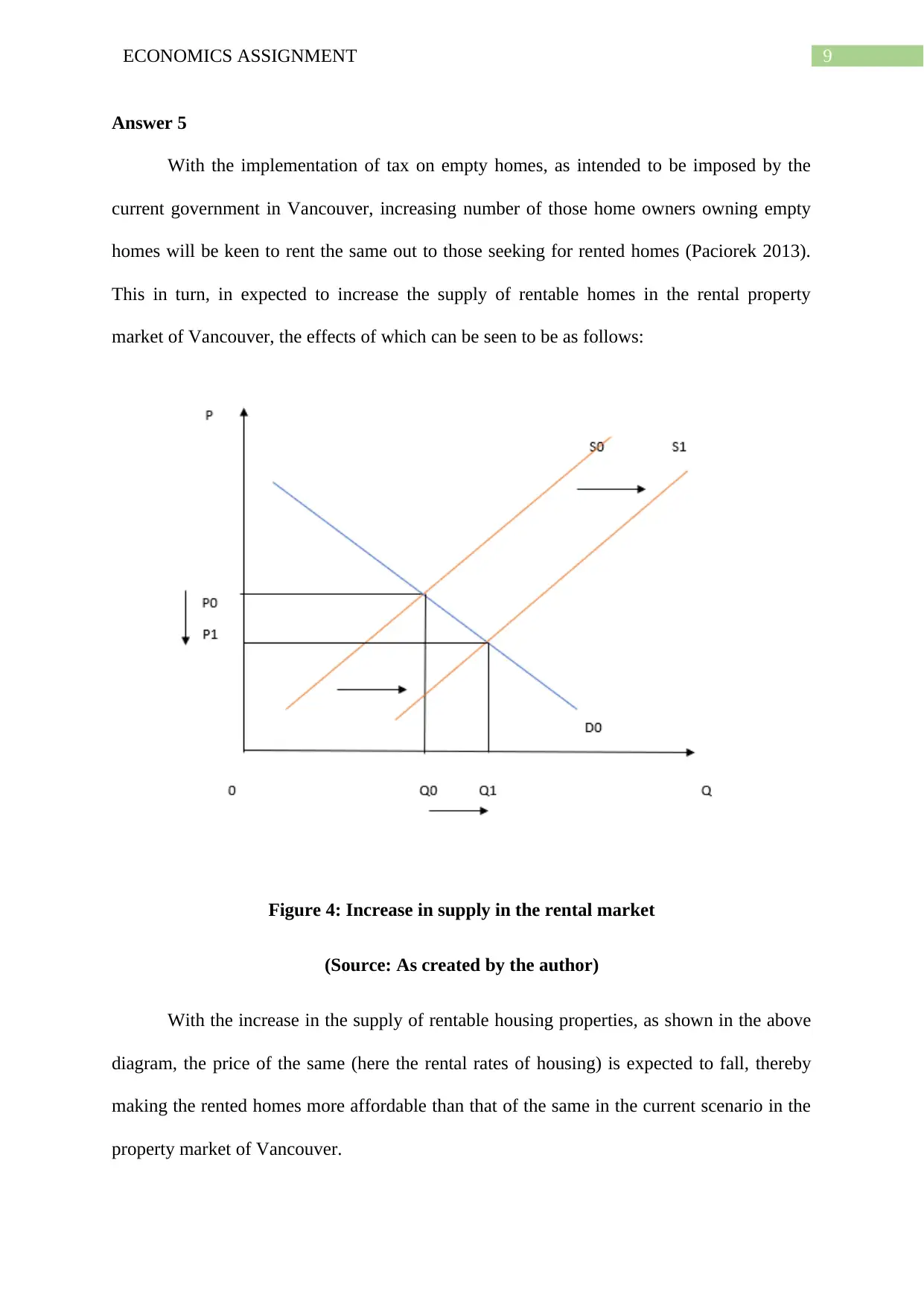
9ECONOMICS ASSIGNMENT
Answer 5
With the implementation of tax on empty homes, as intended to be imposed by the
current government in Vancouver, increasing number of those home owners owning empty
homes will be keen to rent the same out to those seeking for rented homes (Paciorek 2013).
This in turn, in expected to increase the supply of rentable homes in the rental property
market of Vancouver, the effects of which can be seen to be as follows:
Figure 4: Increase in supply in the rental market
(Source: As created by the author)
With the increase in the supply of rentable housing properties, as shown in the above
diagram, the price of the same (here the rental rates of housing) is expected to fall, thereby
making the rented homes more affordable than that of the same in the current scenario in the
property market of Vancouver.
Answer 5
With the implementation of tax on empty homes, as intended to be imposed by the
current government in Vancouver, increasing number of those home owners owning empty
homes will be keen to rent the same out to those seeking for rented homes (Paciorek 2013).
This in turn, in expected to increase the supply of rentable homes in the rental property
market of Vancouver, the effects of which can be seen to be as follows:
Figure 4: Increase in supply in the rental market
(Source: As created by the author)
With the increase in the supply of rentable housing properties, as shown in the above
diagram, the price of the same (here the rental rates of housing) is expected to fall, thereby
making the rented homes more affordable than that of the same in the current scenario in the
property market of Vancouver.
Paraphrase This Document
Need a fresh take? Get an instant paraphrase of this document with our AI Paraphraser
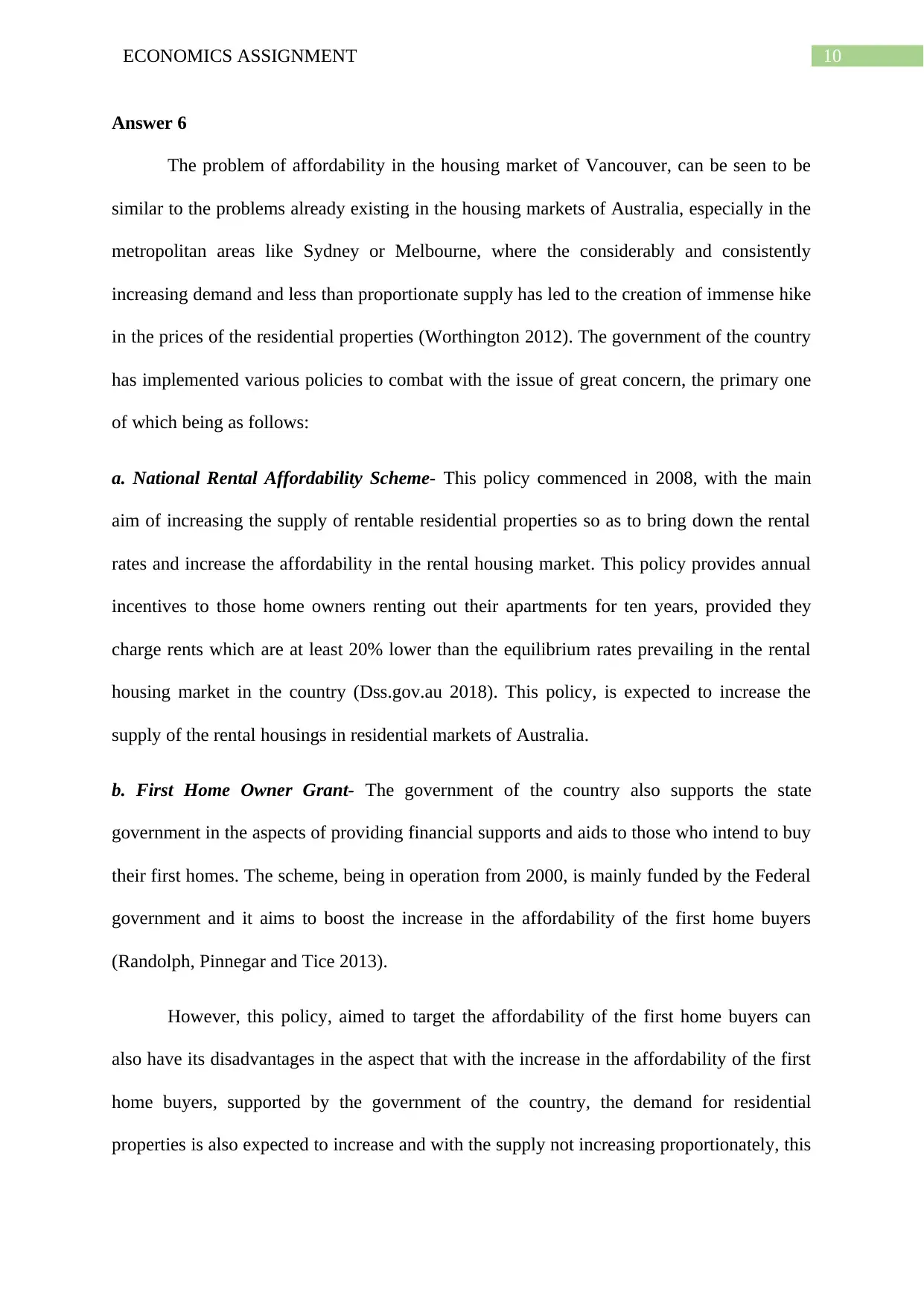
10ECONOMICS ASSIGNMENT
Answer 6
The problem of affordability in the housing market of Vancouver, can be seen to be
similar to the problems already existing in the housing markets of Australia, especially in the
metropolitan areas like Sydney or Melbourne, where the considerably and consistently
increasing demand and less than proportionate supply has led to the creation of immense hike
in the prices of the residential properties (Worthington 2012). The government of the country
has implemented various policies to combat with the issue of great concern, the primary one
of which being as follows:
a. National Rental Affordability Scheme- This policy commenced in 2008, with the main
aim of increasing the supply of rentable residential properties so as to bring down the rental
rates and increase the affordability in the rental housing market. This policy provides annual
incentives to those home owners renting out their apartments for ten years, provided they
charge rents which are at least 20% lower than the equilibrium rates prevailing in the rental
housing market in the country (Dss.gov.au 2018). This policy, is expected to increase the
supply of the rental housings in residential markets of Australia.
b. First Home Owner Grant- The government of the country also supports the state
government in the aspects of providing financial supports and aids to those who intend to buy
their first homes. The scheme, being in operation from 2000, is mainly funded by the Federal
government and it aims to boost the increase in the affordability of the first home buyers
(Randolph, Pinnegar and Tice 2013).
However, this policy, aimed to target the affordability of the first home buyers can
also have its disadvantages in the aspect that with the increase in the affordability of the first
home buyers, supported by the government of the country, the demand for residential
properties is also expected to increase and with the supply not increasing proportionately, this
Answer 6
The problem of affordability in the housing market of Vancouver, can be seen to be
similar to the problems already existing in the housing markets of Australia, especially in the
metropolitan areas like Sydney or Melbourne, where the considerably and consistently
increasing demand and less than proportionate supply has led to the creation of immense hike
in the prices of the residential properties (Worthington 2012). The government of the country
has implemented various policies to combat with the issue of great concern, the primary one
of which being as follows:
a. National Rental Affordability Scheme- This policy commenced in 2008, with the main
aim of increasing the supply of rentable residential properties so as to bring down the rental
rates and increase the affordability in the rental housing market. This policy provides annual
incentives to those home owners renting out their apartments for ten years, provided they
charge rents which are at least 20% lower than the equilibrium rates prevailing in the rental
housing market in the country (Dss.gov.au 2018). This policy, is expected to increase the
supply of the rental housings in residential markets of Australia.
b. First Home Owner Grant- The government of the country also supports the state
government in the aspects of providing financial supports and aids to those who intend to buy
their first homes. The scheme, being in operation from 2000, is mainly funded by the Federal
government and it aims to boost the increase in the affordability of the first home buyers
(Randolph, Pinnegar and Tice 2013).
However, this policy, aimed to target the affordability of the first home buyers can
also have its disadvantages in the aspect that with the increase in the affordability of the first
home buyers, supported by the government of the country, the demand for residential
properties is also expected to increase and with the supply not increasing proportionately, this
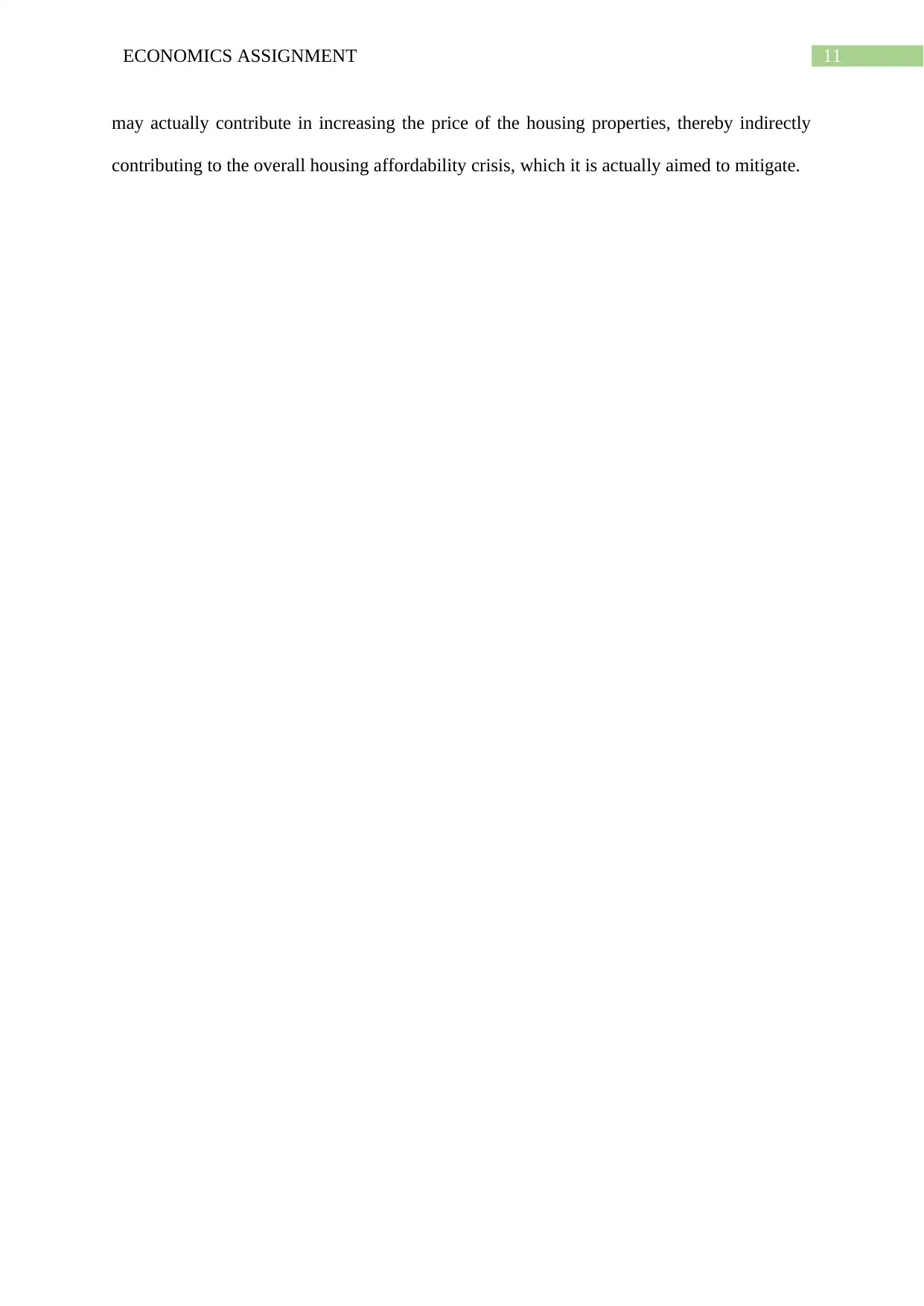
11ECONOMICS ASSIGNMENT
may actually contribute in increasing the price of the housing properties, thereby indirectly
contributing to the overall housing affordability crisis, which it is actually aimed to mitigate.
may actually contribute in increasing the price of the housing properties, thereby indirectly
contributing to the overall housing affordability crisis, which it is actually aimed to mitigate.
⊘ This is a preview!⊘
Do you want full access?
Subscribe today to unlock all pages.

Trusted by 1+ million students worldwide
1 out of 15
Related Documents
Your All-in-One AI-Powered Toolkit for Academic Success.
+13062052269
info@desklib.com
Available 24*7 on WhatsApp / Email
![[object Object]](/_next/static/media/star-bottom.7253800d.svg)
Unlock your academic potential
Copyright © 2020–2025 A2Z Services. All Rights Reserved. Developed and managed by ZUCOL.




